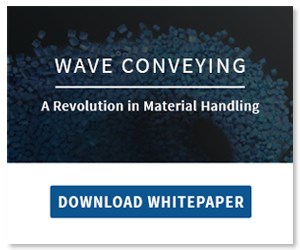You’ve Never Seen Resin Conveying Like This Before
Sponsored ContentYou don’t have to live with the age-old problems of angel hair, snake skins and dust in your plastics conveying systems anymore. New wave conveying technology keeps your industrial machines fed without damaging the material.
Share

There’s no way around it. If you’re moving plastic pellets through vacuum conveyors, you have to deal with the material damage those systems cause. Angel hair, snake skins, dust and other material flaws all come from moving resin pellets through piping. The longer the lines, the more elbows and the softer or more abrasive the materials, the more challenges arise. So you resort to buying more auxiliary equipment like traps, dust filters and special elbows to help mitigate the problem. But you still spend time cleaning and unclogging your equipment to keep the material flowing.
A better solution is to pneumatically convey plastics in a way that prevents materials from getting beat up as they move though your conveying lines.
New conveying technology can do just that—move your materials at comparable output rates yet without the damage. Developed by Conair, Wave Conveying, just may be the wave of the future in pneumatic material handling systems.
How Conveying Works
Most plastics processors use “dilute-phase” vacuum conveying that pulls the material to the discharge point. With a dilute-phase system, constant vacuum pressure “lifts” the material to get it flowing through the system. The point at which material first becomes airborne is called the “saltation”or “pickup” velocity.

The problem with this method is what it does to resin pellets as they travel through the lines at high speeds. With softer materials, like low-density polyethylene and polypropylene, the friction of rubbing against the walls heats the material to cause a partial melt that eventually sticks to the tubing, creating angel hair, snake skins and streamers. More brittle materials, like styrene or polycarbonate, can shatter, creating dust and fines. Abrasive materials, like glass-filled ABS, can wear away the insides of the lines, eventually causing leaks.
An alternative method is “dense-phase” conveying, where the vacuum pressure is higher but is modulated on and off to move the material through the lines in small batches, with air pockets in between. This method is much gentler on the material, and particularly efficient at moving heavier materials.
Dense-phase systems do, however, typically require special equipment and can be prone to clogging, so it’s important to consider the materials and their processing needs.
Enter Wave Conveying
Conair’s new Wave Conveying technology brings the best of both techniques together with a system that lets you use the optimal conveying method for any material. Wave Conveying may appear similar to dense-phase, but it provides much higher throughput and is able to handle a wide range of materials and processes, all while using standard valves, pumps and other system components. The way Conair applies Wave Conveying, the same system is also capable of operating in a dilute-phase mode.
It doesn’t have to be a black and white decision of whether to go dilute or dense. There is a mid-ground to be found that strikes the right balance between required output and material velocity.
Conair’s research found there is a gradual transition from dense- to dilute-phase mode, and has learned how to better control the material in the pipes. This is what they call Wave Conveying, because the material “rolls like a wave on the ocean.”
The key to making it all work together is the system’s FLX-128 Plus controller in combination with the patented Wave System, which is what provides this new level of material control. This is truly a variable-mode conveying system. The FLX-128 Plus control has 10 recipes available for each receiver that automatically adjusts as each receiver creates a demand on the system.
This level of control lets you use whatever phase is best for the resin.
For very light materials, dilute flow may still be the best method, and the system’s control lets you easily set the velocity as low as possible to minimize material damage. For highly abrasive materials, you may still want to use dense phase to save the wear on your equipment.
The Wave Conveying settings are better with materials like PET and acrylic, which are only mildly abrasive, or with light-bulk-density materials like PE sheet flake. Regardless of the phase, conveying can be fine-tuned on the fly, and then the settings can be stored in the control for future reuse.
Who Can Benefit from Wave Conveying?
While designed to help eliminate problems associated with conveying soft or abrasive materials, Wave Conveying has proven itself a viable solution for a variety of materials and applications. Here are a few examples of ways it can be used.
Materials include:
- Polyester
- TPO
- HDPE
- LDPE
- Nylon
- PET – virgin and regrind
- Acrylic
- EVA
- Rigid PVC-filled powder
- Elastomers
- Glass and mineral-filled resins
- Poly Pro and many more
Applications include:
- Wire and cable
- Automotive
- Appliance
- Sheet and film extrusion
- Injection molding
- Medical molding
- Blow molding
- Profile Extrusion
- Recycling
Making the Change
The system is a truly revolutionary development. It is a little bit of magic, a lot of engineering, and some complicated mathematical equations. If this sounds expensive and complicated, it’s not. Because a Wave Conveying system uses standard deep-vacuum pumps, valves and other system components, the cost is only slightly above a typical dilute flow system and existing systems can be converted at a relatively small incremental expense. You’ll also find that Wave Conveying is more energy efficient than dilute flow as well.
Many processors have already made the change and said goodbye to angel hair, snake skins and dust.
For more on Wave Conveying system download the whitepaper or visit the Wave Conveying website where you can directly contact the Conair team.
